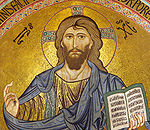- Christianity in Nepal
-
Christianity by Country
North AmericaSouth AmericaOceaniaProtestant Christians came to Nepal primarily through the Nepalese who were living outside of Nepal during and prior to the Rana Regime. After the collapse of Ranas rule in Nepal in 1950, Nepali Christians living in India came in, along with some western missionaries. United Mission to Nepal, International Nepal Fellowship and others are a few earliest western mission agencies that came in and brought Christianity. According to the government data, Protestantism accounts for about 0.45% of the population,[1] but the unofficial number of Christians, including Catholics is between 700,000 to a million. In 2011, the BBC estimated the Christian population to be "less than 5%" of the total population of Nepal, which is roughly 30 million.[2]
Contents
State of the Church in Nepal
Until 1990, most of the church groups in Nepal were united with few exceptions like Assembly of God and Church of Christ. But the democratic changes of 1990 brought relative freedom to practice one's faith. This freedom contributed towards a proliferation of various denominations and groups. Church as a whole in Nepal is an indigenous phenomena with no direct involvement of foreign missionaries. Nepalese themselves took upon the challenge of sharing the gospel and churches came into existence. However, missionaries began to enter the open doors in the decades since 1990.
As a result of missionaries and foreign missions, there are a plethora of foreign funded churches and mission groups in Nepal. Although the church leadership appears to be Nepali in nature, but the Nepali Christian leaders have adopted some of the names and practices as demanded by their donors. The state of the Protestant church in Nepal is a divided house. The single most cause of division has been the leaders' desire to tap in foreign donation. Doctrinally, Nepali church is very much like the New Testament Church and there is hardly any theological debate taking place in Nepal. The denominational division taking place is not for doctrine but for money.
By 2011, Christianity had been growing in Nepal, due to a desire on the part of lower-caste Hindus trying to get opportunities for social advancement.[2]
Persecution
Although the Maoists are responsible for the deaths of many Nepalise, the secularisation of Nepal is largely due to their revolution. Persecution during the Maoists war was not a wholesale rejection of Christianity, it was rather related to individual cases where the Christians refused to co-operate. For that they would persecute anyone, not just Christians. By and large, the church in Nepal continues to enjoy relative freedom and Nepali population is very tolerant of their presence.
Christianity is still considered a foreign religion by the majority of Hindus and Buddhists. If any family member becomes Christian, he or she is sure to face severe opposition from the family and even be completely ostracised by them. Much of the hostility towards Christians stems from the fact that Christians are associated and often in the guise of communists that have terrorized the Nepali population[3]
In 2011, a crisis amongst the Christian community who were not allowed to create new burial grounds for their dead lead to a hunger strike.[2]
See also
Further reading
- Acharya, Babu Ram, “Shri Panch Badamaharajadhiraj Prithvi Narayan Shah Ra Capuchin Padariharu” (His Majesty the King Prithvi Narayan Shah and the Capuchin Fathers), Ramjham, Vol. 6, Iss. 1, 2026 B. S.
- Bhatta, Bhoj Raj, "Creating health and unity in the Nepali Church", Evangelical Missions Quarterly (July, 2010)
- Celebrating 45 Years in Nepal, Kathmandu: United Mission to Nepal, December 1999. Cloud, David W., Rome and the Bible, Port Huron (U. S. A.): Way of Life Literature, 2000.
- Karthak, Solon, Srastaka Triratna (A Collection of Biographies), Kathmandu: Sarikar Prakashan, 1996.
- Khanal, B. P., Pastor Tir Bahadur, Amruwali Kanchho (Biography), Kathmandu: Samdan Publishers, 1998.
- Landon, Perceval, Nepal, Vol. 2, Kathmandu: Ratna Pustak Bhandar, 1976.
- Lindell Jonathan, Nepal and The Gospel of God, New Delhi: United Mission to Nepal, 1979.
- Messerschmidt, Donald A., The Moran of Kathmandu, Bangkok: White Orchid Press, 1997.
- Perry, Cindy, A Biographical History of the Church in Nepal, Kathmandu: Nepal Church History Project, 2000.
- Petech, Luciano (ed.), Tibet Ra Nepalma Italian Dharma Pracharakharu (Italian Missionaries in Tibet and Nepal), Translated into Nepali by Surendra Dhakal, Kathmandu: Royal Nepal Academy, 2060 B. S.
- Rai, Prem Bahadur (ed.), Prakash, Yr. 22, Iss. 24, Mangsir 2060. Ramghat Mandali Smarika Pachasaun Barshikotsab 1952-2002, (Ramghat Church Memoranda Golden Jubilee, Pokhara: Ramghat Church, 2002.
- Ramghat Mandali Chalisau Barshikotsab (1952–1992) (Smarika Ramghat Church 40th Anniversary), Pokhara: Ramghat Church, 1992.
- Regmi, D. R., Medieval Nepal, Vol. II, Calcutta: Firma K. L. Mukhopadhyay, 1966.
- Schreib Claudia, The Nepali Christians: religious Outcasts in A Religious Land, (A field report submitted to the University of Wisconsin College Year in Nepal 1988-1089) June 22, 1989.
- Sebastian, Roy (ed.), Fifty Years Placed with the Son in Nepal, Kathmandu: The Nepal Jesuit Society, 2001.
- Sever, Adrien, Nepal under the Ranas, New Delhi: Oxford and IBH Publishing Co. Pvt. Ltd., 1993.
- Stiller, Ludwig F., Nepal: Growth of a Nation, Kathmandu: Human Resources Development Research Center, 1993.
- Stiller, Ludwig F., The Rise of the House of Gorkha, Patna: Patna Jesuit Society, 1975.
- Vaidya, Tulsi Ram, Jaya Prakash Malla: The Brave Malla King of Kantipur, New Delhi: Anmol Publications Pvt. Ltd. 1996.
- Vaidya, Tulsi Ram, Nepal: A Study of Socio-Economic and Political Changes, New Delhi: Anmol Publications, 1992.
- Vannini, Fulgentius, Christian Settlements in Nepal Duringthe Eighteenth Century, New Delhi: Messers Devarsons, 1977.
References
- ^ "Nepal". International Religious Freedom Report 2004. September 15, 2004. http://www.state.gov/g/drl/rls/irf/2004/35518.htm. Retrieved 2006-06-18.
- ^ a b c "Nepal Christians plan hunger strike over burial ground". BBC. 2011-10-31. http://www.bbc.co.uk/news/world-south-asia-15517207. Retrieved 2011-10-31.
- ^ Christianity, communism & constitution Republica - July 5, 2011
Categories:
Wikimedia Foundation. 2010.

